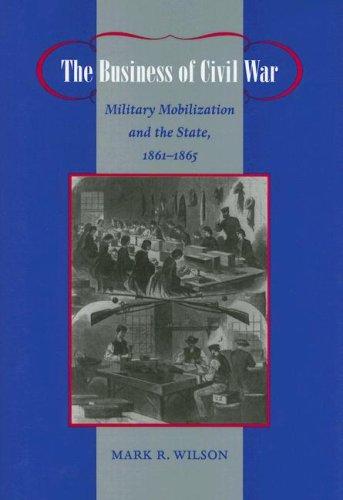The Business of Civil War: Military Mobilization and the State, 1861-1865 by Mark R. Wilson. Johns Hopkins University Press, 2010. Paper, ISBN: 080189820X. $25.00.
 At its core, Mark R. Wilson’s volume on military mobilization during the Civil War is the story of Union procurement principles, policies, and practices. Few observers anticipated that the war would become the humongous enterprise that it became, calling upon military authorities and civil officials to address the challenges posed by mobilization. The result was a patchwork of approaches, attempting to balance questions of cost, efficiency, quality, and social welfare. No overall policy emerged, although several trends were evident, most notably in the centralization of procurement decision-making in the federal government. State-centered mobilization in 1861 offered governors and state politicians opportunities to reward supporters and solidify political advantages, but by year’s end the federal government had largely taken charge of the procurement process. Preserving the Union meant increasing uniformity in procedures and in the goods procured, an important issue when it came to resupply and replenishment (although the diversity of United States firearms issued during the war continued to provide a logistical challenge). Yes, there was scandal aplenty, real as well as rumored, as the system of private contracts offered opportunity for greed; however, the fact remained that as the war grew in size and length, state governments found themselves overwhelmed by the tasks confronting them.
At its core, Mark R. Wilson’s volume on military mobilization during the Civil War is the story of Union procurement principles, policies, and practices. Few observers anticipated that the war would become the humongous enterprise that it became, calling upon military authorities and civil officials to address the challenges posed by mobilization. The result was a patchwork of approaches, attempting to balance questions of cost, efficiency, quality, and social welfare. No overall policy emerged, although several trends were evident, most notably in the centralization of procurement decision-making in the federal government. State-centered mobilization in 1861 offered governors and state politicians opportunities to reward supporters and solidify political advantages, but by year’s end the federal government had largely taken charge of the procurement process. Preserving the Union meant increasing uniformity in procedures and in the goods procured, an important issue when it came to resupply and replenishment (although the diversity of United States firearms issued during the war continued to provide a logistical challenge). Yes, there was scandal aplenty, real as well as rumored, as the system of private contracts offered opportunity for greed; however, the fact remained that as the war grew in size and length, state governments found themselves overwhelmed by the tasks confronting them.
As Wilson reminds us, the United States Army and the military bureaucracy that supported it was one of the American republic’s most durable national institutions (a fact that would also become apparent during Reconstruction, when it was left to the army to administer congressional initiatives). Veteran staff officers supervised the logistical mobilization of the Union war machine and shaped procurement policies, although Wilson goes too far in suggesting that they managed a “national war economy,” for that would include the mobilization of national finances overseen by the Treasury Department as well as other legislative measures to support the war effort (35). During the first half of the nineteenth century the nation’s military bureaucracy grew and evolved as a response to lessons learned during military conflict as well as to the expansion of the army’s responsibilities in defending, exploring, and developing a continental empire. Unlike many other aspects of the infant American state, the military was mostly insulated from the impact of political events, especially the turnover implicit in the spoils system of patronage, allowing for the development of expertise. Wilson traces the evolution of logistical bureaucracy, especially the Quartermaster’s Department, suggesting that by 1861 there were experienced officers in place who were ready to meet the challenge before them, none more so than Quartermaster General Montgomery Meigs.
Throughout the war military authorities sought to strike a balance between various concerns. Should the United States manufacture its own munitions, accoutrements, and uniforms, or should it contract to purchase these items from private enterprises? How should one balance sending proposals out for bid with assuring quality results? How best to make sure that opportunities to win contracts were distributed fairly throughout the country and not concentrated in a few select areas? Did not state-managed manufacturing open opportunities for northern women, especially those whose directly affected by the departure of men for military service? How would the government pay off its obligations when cash was scarce? Did not the inability to pay off those obligations encourage private contracts at the expense of public manufacture (where workers would need to be paid)? Did not private contracting lead to corruption, war profiteering, and the like? Wilson explores the challenges posed by these questions and the compromises that proved acceptable responses. For example, no study of war finance would be complete without taking into account the federal government’s decision to issue certificates of indebtedness in lieu of cash payments, creating a new medium of exchange, speculation, and discounting. In certain cases, several firms proved to have special advantages in providing products ranging from heavy ordnance and wagons to wool textiles and rubber blankets. Although naval affairs are somewhat overshadowed by army matters in this narrative, Wilson pays attention to the development of a wartime navy, complete with contracts for ironclads and riverline vessels that proved essential to Union military success in the West. Finally, Wilson provides a concise overview of demobilizationthat helped to close out this episode in American war-making.
Wilson’s description of these various interactions, grounded in exhaustive archival research, is impressive. At times it becomes repetitive, and occasionally it is difficult to draw generalizations from the wealth of detailed information provided. One will learn much about Americans’ reaction to the social and political impact of economic development in their responses to the emergence of a wartime economy, as themes of exploitation and greed common to a critique of capitalism appeared time and again, as did expressions of concern about social welfare and government waste. These contemporary complaints collide with postwar celebrations of efficiency offered by social reformers such as Edward Bellamy, who appeared enamored by the military model of organization. Wilson claims that what happened during the Civil War represented a step in state building; the model of military organization and supposed efficiency foreshadowed the transformation of the state in the Progressive period several decades later. This argument seems mainly rhetorical, a case of memory and recollection overwhelming reality. The men who oversaw the war machine did not usher in an age of the powerful nation-state; rather, the language of imagined military efficiency became part of the rhetoric of systemization and bureaucratization that was part and parcel of the call for increased federal intervention in the economic order. Wilson is hard pressed to demonstrate how Civil War lessons and legacies became institutionalized as policy and practice. In truth, the war machine demobilized quickly and returned to prewar patterns; only in later years did critics of uncontrolled capitalism draw upon their imaginations to fashion a case for regulation and government intervention.
This reservation aside, readers will find Wilson’s deeply researched account well worth the investment as a study of wartime political economy. It explores areas hitherto mostly neglected and rarely explored: readers will profit from learning how Union authorities procured the material means used to save the Union.
Brooks D. Simpson is the ASU Foundation Professor of History at Arizona State University and most recently the author of The Civil War in the East.
